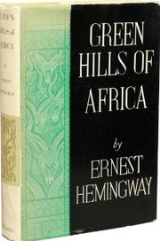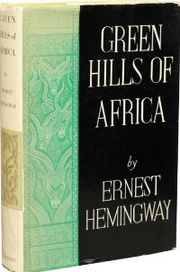
Green Hills of Africa
Encyclopedia

Ernest Hemingway
Ernest Miller Hemingway was an American author and journalist. His economic and understated style had a strong influence on 20th-century fiction, while his life of adventure and his public image influenced later generations. Hemingway produced most of his work between the mid-1920s and the...
(July 21, 1899 – July 2, 1961). Hemingway's second work of nonfiction, Green Hills of Africa is an account of a month on safari he and his wife, Pauline Marie Pfeiffer
Pauline Pfeiffer
Pauline Marie Pfeiffer was the second wife of the writer Ernest Hemingway. She was born in Parkersburg, Iowa, on July 22, 1895, moving to St. Louis in 1901 where she went to school at Visitation Academy of St. Louis...
, took in East Africa during December 1933. Green Hills of Africa is divided into four parts: Pursuit and Conversation, Pursuit Remembered, Pursuit and Failure, and Pursuit as Happiness, each of which plays a different role in the story.
Synopsis
Much of narrative describes Hemingway's adventures hunting in East AfricaEast Africa
East Africa or Eastern Africa is the easterly region of the African continent, variably defined by geography or geopolitics. In the UN scheme of geographic regions, 19 territories constitute Eastern Africa:...
, interspersed with ruminations about literature and authors. Generally the East African landscape Hemingway describes is in the region of Lake Manyara
Lake Manyara
Lake Manyara is a shallow lake in the Natron-Manyara-Balangida branch of the Great Rift Valley in Tanzania. Said by Ernest Hemingway to be the "loveliest [lake] .....
in Tanzania
Tanzania
The United Republic of Tanzania is a country in East Africa bordered by Kenya and Uganda to the north, Rwanda, Burundi, and the Democratic Republic of the Congo to the west, and Zambia, Malawi, and Mozambique to the south. The country's eastern borders lie on the Indian Ocean.Tanzania is a state...
.
The book starts with Part 1 ("Pursuit and Conversation"), with Hemingway and a European expat in conversation about American writers. Relations between the white hunters and native trackers are described, as well as Hemingway's jealousy of the other hunters. Part 2 ("Pursuit Remembered") presents a flashback of hunting in northern Tanzania
Tanzania
The United Republic of Tanzania is a country in East Africa bordered by Kenya and Uganda to the north, Rwanda, Burundi, and the Democratic Republic of the Congo to the west, and Zambia, Malawi, and Mozambique to the south. The country's eastern borders lie on the Indian Ocean.Tanzania is a state...
with a description of the Rift Valley
Rift Valley
In order of specificity, Rift Valley can refer to:*a rift valley in general*the Great Rift Valley*the Rift Valley fever*the valley of the East African Rift*Rift Valley Province, Kenya and border with Uganda...
and descriptions of how to field dress prey. Hemingway kills a rhino, but Karl kills a bigger one. The literary discussion moves to European writers such as Tolstoy
Tolstoy
Tolstoy, or Tolstoi is a prominent family of Russian nobility, descending from Andrey Kharitonovich Tolstoy who served under Vasily II of Moscow...
, Flaubert, Stendhal
Stendhal
Marie-Henri Beyle , better known by his pen name Stendhal, was a 19th-century French writer. Known for his acute analysis of his characters' psychology, he is considered one of the earliest and foremost practitioners of realism in his two novels Le Rouge et le Noir and La Chartreuse de Parme...
, and Dostoevsky. In Part 3 ("Pursuit and Failure") the action returns to the present with Hemingway unlucky in hunting, unable to find a kudu
Kudu
The kudus are two species of antelope of the genus Tragelaphus:*Lesser Kudu, Tragelaphus imberbis*Greater Kudu, Tragelaphus strepsiceros- Etymology :...
he tracks. He moves to an untouched piece of country with the native trackers. In Part 4 ("Pursuit and Happiness") Hemingway and some of his trackers arrive at seemingly virgin country. There he kills a kudu bull with huge horns (52 inches). Back in the camp, he discovers that Karl killed a kudu with bigger horns. He complains that Karl is a terrible hunter with infinite luck. On the last day he learns that many of the guides consider him a brother.
Background and publication history
Green Hills of Africa (1935) initially appeared in serialization in Scribner's MagazineScribner's Magazine
Scribner's Magazine was an American periodical published by the publishing house of Charles Scribner's Sons from January 1887 to May 1939. Scribner's Magazine was the second magazine out of the "Scribner's" firm, after the publication of Scribner's Monthly...
, and was published in 1935. An autobiographical account of his 1933 trip to Africa, Hemingway presents the subject of big game hunting in a non-fiction form in Green Hills of Africa. The serialization occurred from May to November of 1935. The book was published on 25 October 1935 to a first edition
First edition
The bibliographical definition of an edition includes all copies of a book printed “from substantially the same setting of type,” including all minor typographical variants.- First edition :...
print-run of 10,500 copies.
Reception
Green Hills of Africa initially got a cool reception. Writing for The New York TimesThe New York Times
The New York Times is an American daily newspaper founded and continuously published in New York City since 1851. The New York Times has won 106 Pulitzer Prizes, the most of any news organization...
, critic John Chamberlain claimed: "Green Hills of Africa" is not one of the major Hemingway works. Mr. Hemingway has so simplified his method that all his characters talk the lingo perfected in "The Sun Also Rises," whether these characters are British, Austrian, Arabian, Ethiopian or Kikuyu." However, two days later, writing for the same newspaper, critic C. G. Poore hailed The Green Hills of Africa as "the best-written story of big-game hunting anywhere I have read. And more than that. It's a book about people in unacknowledged conflict and about the pleasures of travel and the pleasures of drinking and war and peace and writing." Despite the better review, Hemingway said the book critics "killed" the book. He went into a deep depression, and said he was " 'ready to blow my lousy head off' ". Within a few months he was ready to blame the corrupting influence of the wealthy women in his life—his wife Pauline and his mistress Jane Mason. The result of his bitterness were two stories about Africa: "The Short Happy Life of Francis Macomber
The Short Happy Life of Francis Macomber
"The Short Happy Life of Francis Macomber" is a short story by Ernest Hemingway. Set in Africa, it was published in the September 1936 issue of Cosmopolitan magazine concurrently with "The Snows of Kilimanjaro"...
" and "The Snows of Kilimanjaro
The Snows of Kilimanjaro
"The Snows of Kilimanjaro" is a short story by Ernest Hemingway. It was first published in Esquire magazine in 1936. It was republished in The Fifth Column and the First Forty-Nine Stories in 1938, The Snows of Kilimanjaro and Other Stories in 1961, and is included in The Complete Short Stories of...
", that featured husbands married to domineering women.
Literary analysis
The foreword of Green Hills of Africa immediately identifies this as a work of nonfiction that should be compared with similar works of fiction:
Unlike many novels, none of the characters or incidents in this book is imaginary. Any one not finding sufficient love interest is at liberty, while reading it, to insert whatever love interest he or she may have at the time. The writer has attempted to write an absolutely true book to see whether the shape of a country and the pattern of a month's action can, if truly presented, compete with a work of the imagination.
The book is well known today for a line that has nearly nothing to do with its subject. This quote is frequently used as evidence that The Adventures of Huckleberry Finn is The Great American Novel:
The good writers are Henry JamesHenry JamesHenry James, OM was an American-born writer, regarded as one of the key figures of 19th-century literary realism. He was the son of Henry James, Sr., a clergyman, and the brother of philosopher and psychologist William James and diarist Alice James....
, Stephen CraneStephen CraneStephen Crane was an American novelist, short story writer, poet and journalist. Prolific throughout his short life, he wrote notable works in the Realist tradition as well as early examples of American Naturalism and Impressionism...
, and Mark TwainMark TwainSamuel Langhorne Clemens , better known by his pen name Mark Twain, was an American author and humorist...
. That's not the order they're good in. There is no order for good writers.... All modern American literature comes from one book by Mark Twain called Huckleberry Finn. If you read it you must stop where the Nigger Jim is stolen from the boys. That is the real end. The rest is just cheating. But it's the best book we've had. All American writing comes from that. There was nothing before. There has been nothing as good since.
One episode in Green Hills of Africa is Hemingway's conversation with the Austrian hunter Kandisky, whom Hemingway stops to help when Kandisky's truck breaks down. After initially trading opinions on German writers like Rainer Maria Rilke
Rainer Maria Rilke
René Karl Wilhelm Johann Josef Maria Rilke , better known as Rainer Maria Rilke, was a Bohemian–Austrian poet. He is considered one of the most significant poets in the German language...
and Thomas Mann
Thomas Mann
Thomas Mann was a German novelist, short story writer, social critic, philanthropist, essayist, and 1929 Nobel Prize laureate, known for his series of highly symbolic and ironic epic novels and novellas, noted for their insight into the psychology of the artist and the intellectual...
, Hemingway and the Austrian later discuss American literature over dinner, and it turns out that one of the few American writers Hemingway approves of is Henry James, whom he mentions twice.
Specifically, Hemingway says: "The good American writers are Henry James
Henry James
Henry James, OM was an American-born writer, regarded as one of the key figures of 19th-century literary realism. He was the son of Henry James, Sr., a clergyman, and the brother of philosopher and psychologist William James and diarist Alice James....
, Stephen Crane
Stephen Crane
Stephen Crane was an American novelist, short story writer, poet and journalist. Prolific throughout his short life, he wrote notable works in the Realist tradition as well as early examples of American Naturalism and Impressionism...
, and Mark Twain
Mark Twain
Samuel Langhorne Clemens , better known by his pen name Mark Twain, was an American author and humorist...
” and adds later that “Henry James wanted to make money. He never did, of course”. Intermixed with these comments on James, Crane, and Twain are Hemingway’s views of American writers in general, most of whom, he says, came to a bad end. When Kandisky asks about himself Hemingway tells him, "I am interested in other things. I have a good life but I must write because if I do not write a certain amount I do not enjoy the rest of my life.” When asked what he wants, Hemingway replies, “To write as well as I can and learn as I go along. At the same time I have my life which I enjoy and which is a damned good life."

